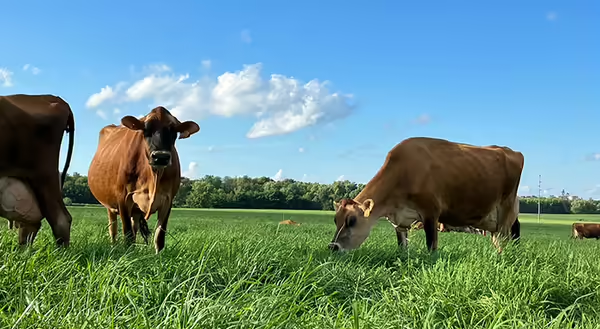
Milk is so synonymous with a grocery store visit; it is permanently printed on your shopping list notepad. With an entire industry supporting this staple item, there are tens of thousands of farms across the country that feed into it. However, few consumers rarely give credit to the work vested in filling that bottle.
The dedicated staff at Kilgus Farmstead in Fairbury, Illinois have redefined everything you thought you knew about milk – and more importantly, the cows that produce it. The family-run farm manages a 170 head herd; milking, processing, and bottling milk that is sold directly to the consumer.
The Kilgus family has been dairying in Central Illinois since 1950 when Paul’s father, Duane Kilgus, bought some small acreage and the first 30-cow milking herd. They were Holsteins – big black and white cows that most people envision with the words “dairy cow.” Holsteins produce the most milk of any breed – and this worked well for the family, until Multiple Component Pricing was proposed in the late 1980s.
Under component pricing milk class rules, dairy managers were paid for milk production based on pounds of butter fat, protein, and solids content in milk, instead of sheer volume produced. This change caused renewed interest in alternative dairy cow breeds that produce a richer milk (higher in protein and fat content) when compared to Holsteins.
Enter, the Jersey cow.
With the new component pricing, the higher fat and protein content in Jersey cows earned Kilgus farm more money for the same volume of milk. Although “Holsteins produce more milk than Jersey, Jersey feed efficiency is much better,” Paul says. In other words, for the cost of a set amount of feed, the Jersey cows gained more weight; it cost less to raise these cows for milking. The Jersey cow is also a smaller animal. “It turned out, they fit our barn and equipment better. After the Jersey herd purchase, we never looked back.”
The milk that is produced by Jersey cows at Kilgus is anything but ordinary. In “Feeding for Milk Components and Profit” by J.W. Schroeder, a North Dakota State University Extension Dairy Specialist, Jersey cow milk was found to have the highest protein and fat content of the top five common dairy breeds in the U.S. This milk is nutritionally dense! While most agree that a high-protein diet is healthy, some shy away from the higher fat content.
Paul challenged me to look under the hood. “Not all fats are created equal, as many are finding out. There is a lot out there now on the benefits of Omega-3 fatty acids. Animals eating pasture-centric diets have much higher Omega-3 and CLAs (conjugated linoleic acids) than conventionally raised cows, for example.”
Once rotational grazing at Kilgus Farmstead started, Paul didn’t want to send his milk away to a distributor. “We felt what we were doing here was special. But it was getting pooled with everyone else’s milk at the time; we looked into what it would take to bottle ourselves.”
In 2009, they decided to begin bottling their own milk on-farm. With this decision, the Kilgus family was able to offer a local, nutrient-dense product that told a story.
ABOUT THE AUTHOR: Nick Frillman is a local foods and small farms educator serving Livingston, McLean, and Woodford Counties. A fourth-generation graduate from University of Illinois, Frillman has a B.A. with a double major of Political Science and Spanish and a M.S. in Crop Science with a focus on crop production. Before joining Illinois Extension, Frillman completed a field season of CSA and farmers’ market-style production at a small “beyond-organic” vegetable farm in Sandy, Oregon.
ABOUT THE EDITOR: Liz Repplinger is an agriculture and natural resources program coordinator serving Livingston, McLean, and Woodford Counties. A Bloomington-Normal native, Liz earned a B. A. and M.S. in Animal Science from Illinois State University. She has enjoyed contributing to the multiple facets of Extension including previous support of the 4-H Youth Development Program as a program coordinator and current support of Unit and Statewide Diversity, Equity and Inclusion Initiatives.